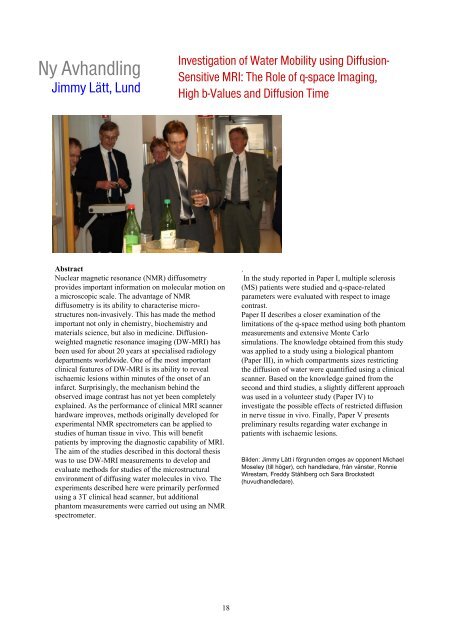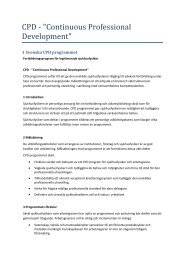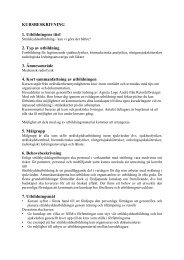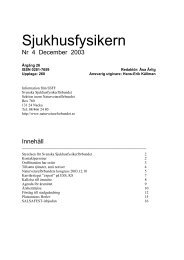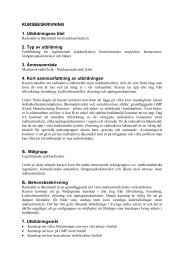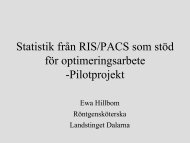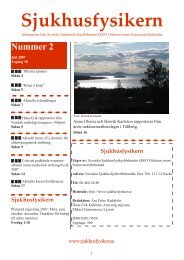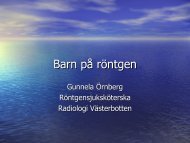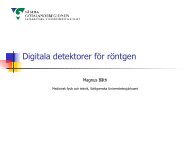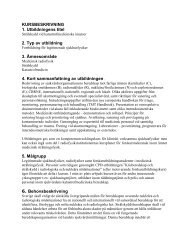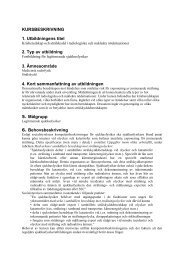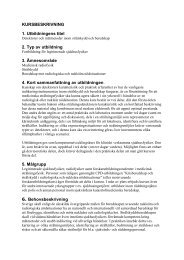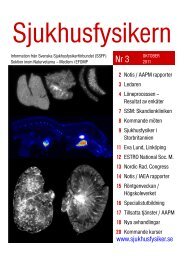Sjukhusfysikern - Svenska SjukhusFysikerFörbundet
Sjukhusfysikern - Svenska SjukhusFysikerFörbundet
Sjukhusfysikern - Svenska SjukhusFysikerFörbundet
You also want an ePaper? Increase the reach of your titles
YUMPU automatically turns print PDFs into web optimized ePapers that Google loves.
Ny Avhandling<br />
Jimmy Lätt, Lund<br />
Abstract<br />
Nuclear magnetic resonance (NMR) diffusometry<br />
provides important information on molecular motion on<br />
a microscopic scale. The advantage of NMR<br />
diffusometry is its ability to characterise microstructures<br />
non-invasively. This has made the method<br />
important not only in chemistry, biochemistry and<br />
materials science, but also in medicine. Diffusionweighted<br />
magnetic resonance imaging (DW-MRI) has<br />
been used for about 20 years at specialised radiology<br />
departments worldwide. One of the most important<br />
clinical features of DW-MRI is its ability to reveal<br />
ischaemic lesions within minutes of the onset of an<br />
infarct. Surprisingly, the mechanism behind the<br />
observed image contrast has not yet been completely<br />
explained. As the performance of clinical MRI scanner<br />
hardware improves, methods originally developed for<br />
experimental NMR spectrometers can be applied to<br />
studies of human tissue in vivo. This will benefit<br />
patients by improving the diagnostic capability of MRI.<br />
The aim of the studies described in this doctoral thesis<br />
was to use DW-MRI measurements to develop and<br />
evaluate methods for studies of the microstructural<br />
environment of diffusing water molecules in vivo. The<br />
experiments described here were primarily performed<br />
using a 3T clinical head scanner, but additional<br />
phantom measurements were carried out using an NMR<br />
spectrometer.<br />
Investigation of Water Mobility using Diffusion-<br />
Sensitive MRI: The Role of q-space Imaging,<br />
High b-Values and Diffusion Time<br />
18<br />
.<br />
In the study reported in Paper I, multiple sclerosis<br />
(MS) patients were studied and q-space-related<br />
parameters were evaluated with respect to image<br />
contrast.<br />
Paper II describes a closer examination of the<br />
limitations of the q-space method using both phantom<br />
measurements and extensive Monte Carlo<br />
simulations. The knowledge obtained from this study<br />
was applied to a study using a biological phantom<br />
(Paper III), in which compartments sizes restricting<br />
the diffusion of water were quantified using a clinical<br />
scanner. Based on the knowledge gained from the<br />
second and third studies, a slightly different approach<br />
was used in a volunteer study (Paper IV) to<br />
investigate the possible effects of restricted diffusion<br />
in nerve tissue in vivo. Finally, Paper V presents<br />
preliminary results regarding water exchange in<br />
patients with ischaemic lesions.<br />
Bilden: Jimmy Lätt i förgrunden omges av opponent Michael<br />
Moseley (till höger), och handledare, från vänster, Ronnie<br />
Wirestam, Freddy Ståhlberg och Sara Brockstedt<br />
(huvudhandledare).


